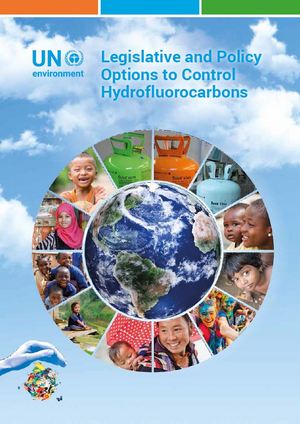Legislative and policy options to control hydrofluorocarbons
 UN Environment OzonAction is assisting all developing countries (Article 5 under the Montreal Protocol) through its networks of National Ozone Officers (146 developing countries), clearinghouse and capacity-building activities to implement their national hydrochlorofluorocarbons (HCFC) phase-out. OzonAction supports efforts to phase out HCFCs, adopt non-ozone depleting, non global warming and energy-efficient alternatives in a safe and sustainable manner, ultimately protecting our common global property – the Earth’s ozone layer.
UN Environment OzonAction is assisting all developing countries (Article 5 under the Montreal Protocol) through its networks of National Ozone Officers (146 developing countries), clearinghouse and capacity-building activities to implement their national hydrochlorofluorocarbons (HCFC) phase-out. OzonAction supports efforts to phase out HCFCs, adopt non-ozone depleting, non global warming and energy-efficient alternatives in a safe and sustainable manner, ultimately protecting our common global property – the Earth’s ozone layer.
The most commonly used alternatives to HCFCs are hydrofluorocarbons (HFCs). These substances belong to the so-called “Kyoto Protocol basket of greenhouse gases”. They have a high global warming potential (GWP), but do not deplete the ozone layer, so they are commonly used as substitutes for ozone depleting substances (ODS), especially for HCFCs. Since based on the provisions of the Montreal Protocol (MP), the global consumption and production of the HCFCs is currently being phased out – the HFCs are being phased in. It is estimated that in 2015 a minimum 525,000 metric tons of these substances were produced and consumed globally. If this trend is not stopped the HFCs will become major (6-9 %) contributors to climate change by 2050. Taking this threat into account the Parties to the Montreal Protocol endorsed in October 2016 the so-called “Kigali Amendment” which introduced to the MP the controls on consumption and production of HFCs.
In order to follow and facilitate the HFC phase-down schedules contained in the Kigali Amendment, the Parties, including both developed and developing countries, will have to implement certain measures. This booklet contains a recommended set of legislative and policy options which the developing (Article 5) countries may wish to consider for implementation. It is intended to be a guide/tool for countries. It complements the previous publication “HCFC Policy & Legislative Options: A Guide for Developing Countries“(2010).
- Chapter 1 – describes the interlinkages and relationship between HCFC phase-out and HFC phasedown. In the next chapters the options are grouped according to their functions which can be easily recognised by function-specific pictograms.
- Chapter 2 – deals with options related to monitoring and controlling the trade in HFCs such as import quotas and exemption from quotas, mandatory reporting by HFC importers and exporters as well as different types of bans and restrictions concerning HFCs and products and equipment containing or relying on HFCs.
- Chapter 3 – describes the possibility of introducing specific HFC phase-down schedules and bans that would restrict the use of HFCs, including a ban on new HFC installations.
- Chapter 4 – contains options related to record keeping on HFCs and HFC-containing products and equipment, namely the establishment of HFC substance logbooks and HFC equipment logbooks.
- Chapter 5 – explains the HFC emission control measures such as mandatory leakage checks that can be introduced in order to diminish HFC emissions and thus reduce the demand for servicing of equipment containing or relying on HFCs.
- Chapter 6 – provides recommendations related to awareness raising among stakeholders and capacity building in the context of HFC phase-down, including the issue of the training of customs and environmental officers and the training and certification of refrigeration technicians.
Each section devoted to a specific option contains a general description of that option as well as the advantages and disadvantages of its implementation, criteria for the relevant decision-making and the selection of the appropriate timing, support measures which can be introduced to make the implementation more effective, status of implementation in certain countries and linkages to the related references.
The options are also color-coded to indicate the suggested timing for implementation: orange – implementation to accompany ratification of the Kigali Amendment, blue – implementation before the freeze date and green – implementation at a later stage of the HFC phase-down process. The recommended schedule of implementation of each option in Group 2 Article 5 countries (GCC states, India, Iran, Iraq and Pakistan) and Group 1 Article 5 countries (all other Article 5 countries) is contained in the “Conclusions” chapter. The options to be implemented as quickly as possible after the data on HFC consumption in the country are available from a national HFC inventory (so that the general strategy for HFC phase-down can be developed) include: starting the process of awareness raising among stakeholders, introducing the emission control measures and mandatory reporting by HFC importers and exporters. It is recommended that the establishment of national annual import quotas for HFCs and the introduction of some restrictions on the placing on the market of products and equipment containing HFCs, as well as the training of customs officers and refrigeration
technicians on HFCs, could be the next steps for implementation.
Annexes to the booklet contain the full text of the Kigali Amendment and related decisions of the Parties, HFC phase-down schedules mandatory for Article 5 and non-Article 5 countries, HFC equipment logbook, recommended customs codes and classification of HFCs and other fluorinated gases and HFC-containing RAC&HP equipment.
OzonAction will continue to work with countries and provide the necessary technical assistance to implement the “enabling activities” identified in the Kigali Amendment for a smooth transition to an HFC phase-down, recognising that there is no “one-size-fits-all”.
